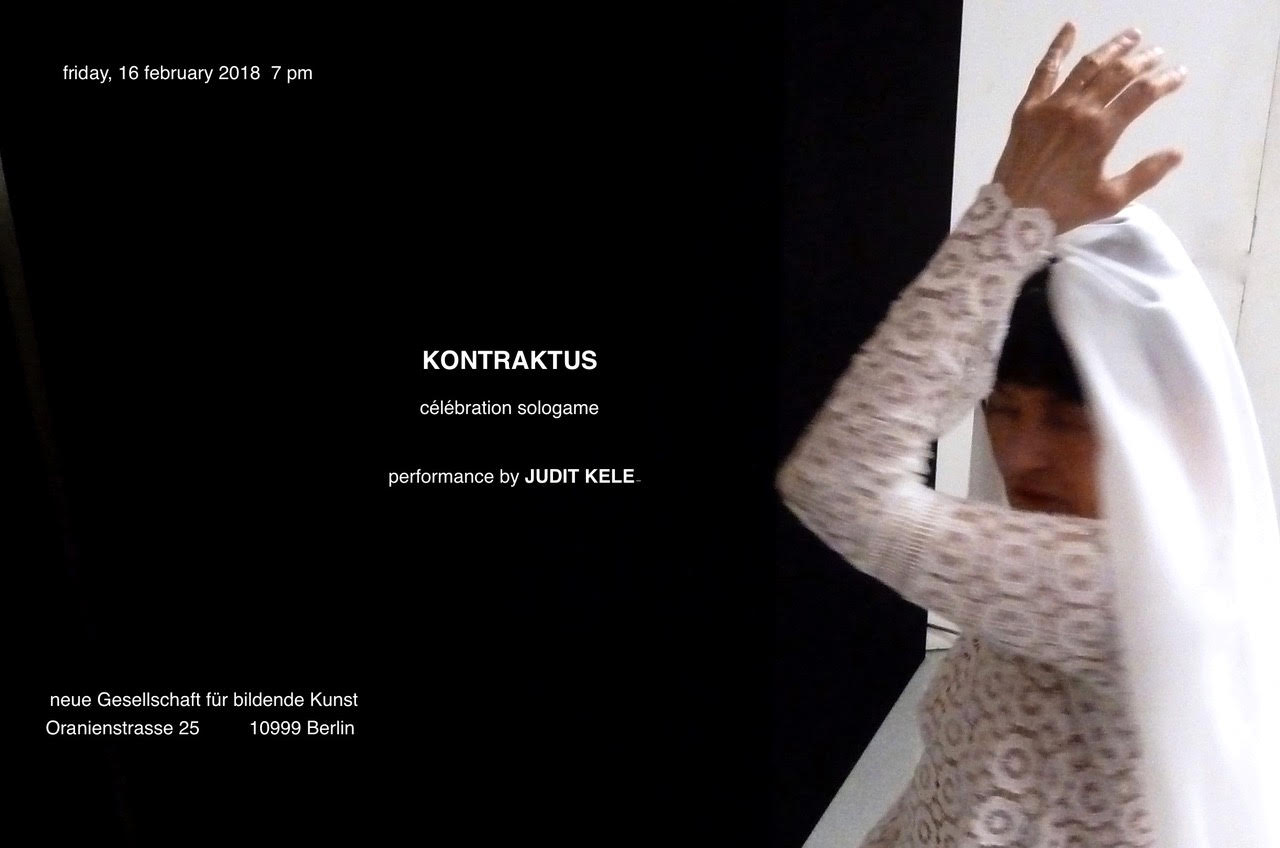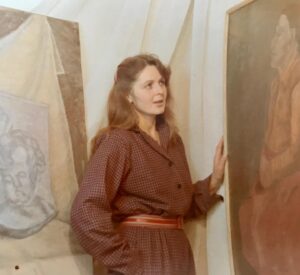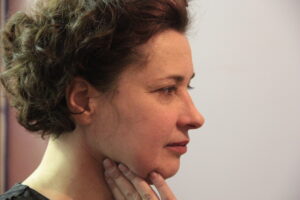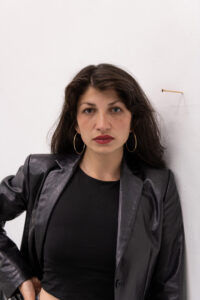Judit Kele
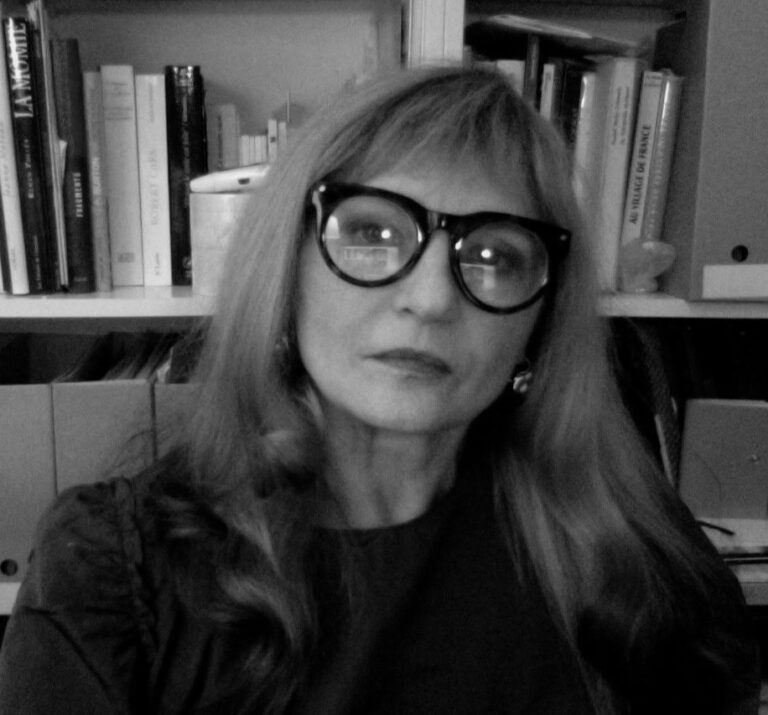
– born in 1944. A Hungarian artist, set and costume designer, film director. She moved to Paris in 1981 where she currently lives and works. Before her moving she worked at the Textile Workshop in Velem, Hungary, where she started to focus on the relationship of body and textile. From 1981 she has been exhibiting in museums until 1985 when she bid farewell to fine art at the last Paris Biennial. Since then she has been working with the medium of film. In her works she often includes her own body and merges the elements of music, fine art, film and performance. Her films won international film festival awards. Her artworks were exhibited at the Ludwig Museum in Budapest, the Musée d’Art Moderne in Paris, the HMKV in Dortmund, the Neue Gesellschaft für Bildende Kunst (ngbk) and at the Pallazzo delle Esposizioni in Rome.
I was born under the influence of the planet Uranus and I came back from death many times in my life. Thus the unexpected events also brought good things. My first experience inside, outside breast milk, is the tremendous amount of snow: clean sheet, white canvas. Then the first summer: I woke up in a rose garden, the world was full of color and smell. My mother’s name is Rose.
We lived in Budapest near Lake Feneketlen (Bottomless Lake), our Christmas tree reached the ceiling and one day we found ourselves on the streets with our suitcases. I recovered from this trauma with the support of music and singing. I could only speak by singing, because opera meant an intensified state of mind to me in which it was possible to live and avoid reality.
Finally we put down our suitcases in Angyalföld (Angel’s Land), in the outskirts of Budapest, where the five of us lived in a one bedroom apartment. For Christmas, when other children asked for dolls and strollers, I asked for a box of pencils, stating that the brand has to be the Czech Kohinoor. I drew my dreams and the faces of the tenants on the walls of our house that had a spiral staircase in it. I was the protagonist, this was my first exhibition. Maybe Banksy saw me flying to the sky with a balloon, wearing a crown?
Elementary school was a nightmare, there was nothing between the lowest and highest grades. At the end of the year, eminent students were called by their names for rewards. When I heard my name I hid so I will not be shamed for being the worst student. Thus my drawing teacher shouted my name and showed a certificate from Japan, where she sent my drawings without me noticing and I won the first prize.
My drawing teacher suggested that I apply to a high school with a focus on art, but instead of this I enrolled in a school of economy and industry, because I thought it was more serious.
I left Angyalföld (Angel’s Land) before my final exam by marrying a man living on the luxurious Andrássy Avenue. That was the time when I started to travel the world ecstatically from the then isolated Hungary.
Perhaps this is also the influence of Uranus? I divorced and my next marriage led me to the world of theatre and film, I started to design sets and costumes. I was asked if I had a diploma, because talent and the fact that I can draw and I have fantasy is not enough. Although I lived two steps away from the University of Fine Arts, I was not attracted by the world of panel paintings and by the perspective of being stuck between frames. As a woman, I was predestined to apply for the textile design course of the University of Applied Arts, as women were applying there at that time. Once in a while I participated in courses of the University of Music and the University of Theatre and Film and designed sets and costumes for the pieces created by the students.
In the late 1970s, after graduation, my film Time-Wallpaper1 was screened at the Club of Young Artists’. In the film I am performing the butterfly swimming technique, wearing headphones and a microphone. During the full house screening, Miklós Erdély – influential artist and leading figure of the Hungarian underground art scene – immersed my head in water according to the rhythm of the film in order to baptize me and inaugurate me as an artist.
After this I said goodbye to the never practiced profession of mine, to my textile artist diploma. In the performance called Textile without Textile2 I laid naked on a loom made by my father Joseph an engineer, being the thread loop in the machine. This is the strongest bond I made with myself and art for a lifetime.
I continued this idea of “with myself, about me, about art” in the Museum of Fine Arts. In one of the most famous masterpieces of the museum, I sat in the place of an artwork surrounded by a cordon, I was on loan, guarded by an armed policeman. Behind me – the Annunciation by El Greco was also on loan. This painting symbolizes the fatal sign determination in my life, the desire to create that I have to announce myself then and there. I am a Work of Art (1979)3. A lot of images were taken, but one of them became an icon, as it was in relation with the Zeitgeist of that time, and because I was guarded by a policeman in the museum. Fortunately, the ruling communist power ignored the artistic value and the idea behind the whole action.
In 1980 I posted an advertisement in the French newspaper called Libération. People could bid for me and the collector who offered the highest amount could purchase me as an artwork. In the presence of civil policemen, I married the French collector in Budapest and moved to Paris. Life became my stage where I have to play my destiny.
This is where the real existence of the human-artwork starts, because its value is decreasing by age. My film Transcription de Lucas Cranach/I am Work of Art45 describes this issue with the music of Kaija Saariaho (the artwork was presented at HMKV in Dortmund in 2010).
The indestructible unity of fine art and music was present in almost every work of mine. I participated in the exhibition of Musée d’Art Moderne in 1983 as a musician (Klangplastik concert) and in 1984 I exhibited a sound sculpture (Modelectricité) here. In 1985, I created my piece Csókolom for the music section of Nouvelle Biennale de Paris together with the composer Kaija Saariaho. With this work I left the world of exhibition spaces for a while.
I didn’t even want to hear about galleries, because I was not interested in commercial activity. I wanted to reach a broader audience who can access my works in museums. Following this idea, I ended up working for the television, first as a screenwriter and then as a director.
After this change of media I was still loyal to music. My trilogy of portrait films date about composers György Ligeti (screenwriter), György Kurtág (director), Péter Eötvös (director) were screened all over the world and I received prestigious music and art prizes.
After all that, I returned to fine art with my film about Jeff Koons. In 2018 in Berlin (nGBK Neue Gesellschaft für Bildende Kunst) I married myself (sologamie) in a white wedding gown in my performance titled Konkraktus.67 I swore to myself that from that point on, I will be myself and will do what I was born to do.
My work called I am a Work of Art reminds me of artist Hilma af Klint, who asked her successor to show her work to the world only twenty years after her death, because maybe then it will be understood.
“Art is what makes life more interesting than art.” Robert Filliou of the Fluxus group.
The artist statement was written in collaboration with curator Andrea Soós (2021).
1Image: Judit Kele, Time-Wallpaper, 1979, film and performance. Courtesy of the artist.2Image: Judit Kele, Textile without Textile, 1979, photomontage. Courtesy of the artist.
3Image: Judit Kele, I am a Work of Art, 1979, performance at the Museum of Fine Art, Budapest. Courtesy of the artist.
4Image: Judit Kele, Transcription de Lucas Cranach/I am Work of Art, 2009, stills from the film. Courtesy of the artist.
5mage: Judit Kele, Transcription de Lucas Cranach/I am Work of Art, 2009, stills from the film. Courtesy of the artist.
6Image: Judit Kele, Kontraktus, 2018, performance at ngbk – Neue Gesellschaft für Bildende Kunst, Berlin. Courtesy of the artist.
7Image: Judit Kele, Kontraktus, 2018, performance at ngbk – Neue Gesellschaft für Bildende Kunst, Berlin. Courtesy of the artist.
– szül. 1944 – képzőművész, díszlet-és jelmeztervező, filmrendező 1981-ben költözött Párizsba, ahol jelenleg is él és dolgozik. Kiköltözése előtt dolgozott a Velemi Textilművészeti Alkotótelepen, ahol a textil és a test kapcsolatával kezdett el foglalkozni. 1981-től múzeumokban állított ki és 1985-ben, az utolsó Párizsi Biennálén búcsúzott el a képzőművészettől. Innentől a film médiuma felé fordult. Munkáiban – melyeknek gyakran saját teste is része – a zenét, a képzőművészetet és a filmet a performansz elemeivel vegyíti. Filmjeit nemzetközi fesztiválokon díjazták, munkáit többek között a budapesti Ludwig Múzeumban, a párizsi Musée d’Art Moderne-ben, a dortmundi HMKV-ben és a berlini Neue Gesellschaft Für Bildende Kunst-ban (ngbk) és Rómában a Pallazzo delle Esposizioni–ben mutatták be.
Az Uránusz jegyében születtem és életem során többször jöttem vissza a halálból, de a váratlan események jót is hoztak. Első élményem belül, az anyatejen kívül, a végtelen sok nagy hó: tiszta lap, fehér vászon. Majd az első nyár: rózsakertben ébredtem magamra, a világ csupa szín és illat. Édesanyám neve is Rózsa.
Budapesten a Feneketlen-tónál laktunk, a karácsonyfánk a plafonig ért és onnan egy nap az utcára kerültünk a bőröndjeinkkel. Ebből a traumából a zene és az ének segített ki, csak énekelve tudtam beszélni mert az opera nekem felfokozott állapotot jelentett, amiben elképzelhető volt élni és kikerülni a valóságot.
A bőröndünket végül Angyalföldön tettük le, ahol öten éltünk az egyszobás lakásban. Karácsonykor, amíg a többi gyerek hajasbabát és babakocsit kért ajándékba, én egy doboz színes ceruzát kértem, kikötve, hogy a márka a cseh Kohinoor legyen. Csigalépcsős házunk falait telerajzoltam álmaimmal és a ház lakóinak arcaival, én voltam a főszereplő. Ez volt az első kiállításom. Lehet, hogy Banksy látott engem fejemen a koronával és luftballonnal repülni az ég felé?
Az általános iskola rémálom volt, az egyes és az ötös osztályzatok között nem volt középút. Év végén az iskolai ünnepségen a jó tanulókat név szerint szólították az ajándékokért, és amikor meghallottam a nevemet elbújtam, nehogy szégyen érjen mint a legrosszabb tanuló, de rajztanárnőm kiabálta a nevemet, felmutatva az oklevelet Japánból, ahova tudtomon kívül elküldte a rajzaimat és első díjat nyertem.
Rajztanárnőm tanácsolta, hogy művészeti gimnáziumba menjek, de ehelyett beiratkoztam egy közgazdasági és nehézipari technikumba, mert azt találtam komolynak. Angyalföldről még érettségi előtt férjhez menéssel elmenekültem az Andrássy útra. Innentől elkezdődött az önfeledt utazás a világba az akkor még bezárt Magyarországról.
Talán ez is az Uránusz hatása? Elváltam, a következő házasságom a színház és a film világába vezetett, elkezdtem díszletet és jelmezt tervezni. Itt kérdeztek rá, hogy van-e diplomám, mert a tehetség, meg hogy tudok rajzolni és van fantáziám az nem elég. Hiába laktam a kapujától két lépésre, a Képzőművészeti Főiskola, a táblaképek és keretbe zártság perspektívája nem vonzott. Mint nő, szinte predesztinálva voltam az Iparművészeti Főiskola textil szakára, mert oda jelentkeztek akkoriban a nők. Egy időben átjártam a Zeneművészeti- és a Színművészeti Főiskola óráira és a színművészetis hallgatók vizsgaelőadására terveztem kollégáimmal díszletet és jelmezt.
Az 1970-es évek végén, a diploma után a Fiatal Művészek Klubjában a Time-Wallpaper1 című filmem – amelyben pillangóúszásban merültem be és ki a vízből fülhallgatóval és mikrofonnal a fejemen – vetítésén teltház előtt Erdély Miklós a film ritmusára mártotta fejemet a vízbe, hogy megkereszteljen és “művésszé” avasson.
Ezután következett a búcsúm a soha nem gyakorolt textilművész diplomámtól: a Textil, textil nélkül2 című performansz, ahol apám, József készítette szövőszékre lánc- és vetülékfonalként feküdtem fel anyaszült meztelenül. Ez a legerősebb csomópont, amit magammal kötöttem egy életre a művészetben.
Majd a Szépművészeti Múzeumban folytattam ezt a “magammal-magamról-művészetről” gondolatot. Egyik leghíresebb remekművét éppen kölcsönözte a múzeum, ennek a helyére ültem be kordonnal körülkerítve, fegyveres őrrel védve. A szimbólummal terhes kölcsönadott kép – El Greco Angyali üdvözlete – és alkotási vágyam fatális jel volt az életemben, hogy „itt és most”, a háromnapos élő kiállításomon önmagam mint műalkotást meghirdessem: I am a Work of Art3. Sok fénykép készült, de egy ikon jellegűvé vált, mert erősen kötődött az akkori kor szelleméhez, és mert egy rendőr őrzött a múzeumban. Az akkori hatalom nem mérte fel a művészi értéket, sem a gondolatot, amiért az egészet kitaláltam és megvalósítottam.
1980-ban a Libération francia napilapban feladtam egy hirdetést, ahol a Párizsi Biennálé keretében licitálni lehetett rám, és a legtöbbet kínáló gyűjtő, mint holmi műtárgyat megvásárolhatott. Budapesten, civil ruhás rendőrök jelenlétében hozzámentem a francia vevőhöz, és Párizsba költöztem.
Innentől kezdődik valós léte az élőlény-műalkotásnak, aki az évekkel egyre idősebb, s ahelyett, hogy növekedne, csökken az értéke. Transcription de Lucas Cranach/I am Work of Art45 című filmem mutatja ezt be, Kaija Saariaho zenéjével (2010-ben a HMKV im Dortmunder U-ban mutatták be).
A zene és a képzőművészet megbonthatatlan egysége majdnem minden munkámban jelen volt. 1983-ban a Musée d’Art Moderne-ben, mint zenész (Klanplastik koncert), s ugyanitt 1984-ben (Modelectricité) pedig zenélő szoborral vettem részt. 1985-ben a Nouvelle Biennale de Paris zenei szekciójában Kaija Saariaho zeneszerzővel hoztam létre Csókolom című sokszereplős előadásomat, amivel egy időre búcsút mondtam a kiállítótermeknek.
Galériákról hallani sem akartam, mert az adás-vétel soha nem érdekelt, csak a nagyközönség, aki a múzeumokban hozzáférhet a művekhez. Ennek a gondolatnak a továbbvitele vezetett a televízióhoz, először mint forgatókönyvíró és utána mint rendező.
A műfajváltás után is hűséges maradtam a zenéhez. Portréfilm-trilógiám: Ligeti György (forgatókönyv), Kurtág György (rendező), Eötvös Péter (rendező) eljutott a világ minden tájára és a legmagasabb zenei és művészeti díjakat kaptam elismerésül.
Majd visszatértem a képzőművészethez Jeff Koons-ról készített filmemmel. 2018-ban Berlinben (nGBK Neue Gesellschaft für Bildende Kunst) Kontraktus67 címmel, hófehér menyasszonyi ruhában saját énemmel léptem nászra (sologamie), önmagamnak megesküdtem önmagammal, hogy mostantól csak önmagam leszek és azzal fogok foglalkozni, amire születtem.
I Am A Work Of Art munkámról Hilma af Klint jut eszembe, aki halálakor arra kérte örökösét, hogy csak 20 év elteltével mutassa meg művét a nagyvilágnak, mert talán akkor megértik.
„A művészet teszi érdekesebbé a világot a művészetnél.” – Robert Filliou, fluxusművész.
Az artist statement Soós Andrea kurátorral együttműködésben készült (2021).
1Kép: Kele Judit, Time-Wallpaper, 1979, film, performansz. A művész jóvoltából.2Kép: Kele Judit, Textil textil nélkül, 1979, fotómontázs. A művész jóvoltából.
3Kép: Kele Judit, I am a Work of Art, 1979, élő kiállítás, performansz a budapesti Szépművészeti Múzeumban. A művész jóvoltából.
4Kép: Kele Judit, Transcription de Lucas Cranach/I am Work of Art, 2009, jelenetek a filmből. A művész jóvoltából.
5Kép: Kele Judit, Transcription de Lucas Cranach/I am Work of Art, 2009, jelenetek a filmből. A művész jóvoltából.
6Kép: Kele Judit: Kontraktus, 2018, performansz az Ngbk – Neue Gesellschaft für Bildende Kunst-ban, Berlin. A művész jóvoltából.
7Kép: Kele Judit: Kontraktus, 2018, performansz az Ngbk – Neue Gesellschaft für Bildende Kunst-ban, Berlin. A művész jóvoltából.
